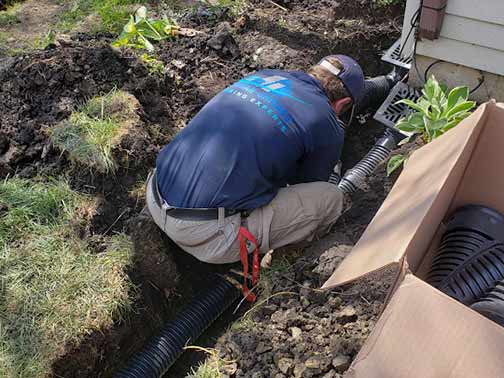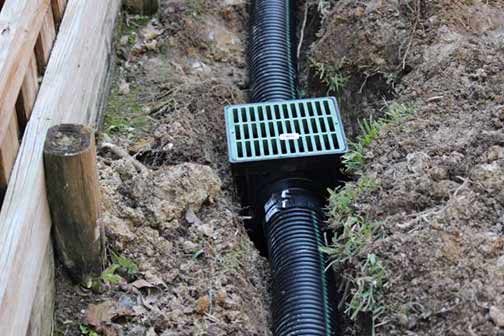Understanding French Drains: A Comprehensive Overview
French drains are an effective solution for managing water drainage around your property. They are designed to channel water away from areas prone to flooding or water accumulation, thereby protecting your home from potential water damage. Below we get into the workings of French drains, their benefits, and how they can be an essential component in safeguarding your home.
The Mechanism of French Drains: How They Work
French drains operate on a simple yet efficient principle. They consist of a perforated pipe buried in a trench filled with gravel. The pipe is designed to collect and redirect water away from your home, reducing the risk of water damage. The trench allows water to flow freely into the pipe, which then carries it to a designated drainage area. This setup prevents water from accumulating around your home’s foundation, which can lead to structural issues over time.
Benefits of Installing French Drains
There are numerous advantages to installing French drains around your property. Firstly, they help prevent water damage to your home’s foundation. Excess water around the foundation can cause it to weaken and crack, leading to costly repairs. Secondly, French drains can mitigate the risk of basement flooding. By redirecting water away from your home, they ensure that your basement remains dry and free from mold and mildew. Additionally, French drains can enhance the overall drainage system of your property, making it more efficient in managing water runoff.
Types of French Drains: Choosing the Right One for Your Home
There are different types of French drains, each suited to specific needs and conditions. The most common type is the traditional French drain, which is installed around the perimeter of a property to manage surface water. Another type is the interior French drain, which is installed inside the basement to address water seepage issues. Additionally, there are curtain drains, which are used to protect large areas of land from water accumulation. Choosing the right type of French drain depends on the specific drainage needs of your property and the areas most susceptible to water damage.
Installation Process: What to Expect
Installing a French drain involves several steps, starting with a thorough assessment of your property’s drainage needs. A trench is then dug around the area where water accumulation is a concern. The trench is lined with a geotextile fabric to prevent soil from clogging the drain. Gravel is added to the trench, followed by the perforated pipe. More gravel is added on top of the pipe, and the trench is covered with soil or sod. The entire process requires careful planning and execution to ensure that the French drain functions effectively.
Maintenance Tips for French Drains
Regular maintenance is crucial to keep your French drain functioning optimally. It is important to periodically inspect the drain for any signs of clogging or damage. Removing debris and sediment from the trench and pipe can help maintain proper water flow. Additionally, ensuring that the discharge area is free from obstructions will prevent water from backing up. Regular maintenance not only prolongs the life of your French drain but also ensures that it continues to protect your home from water damage.

Signs That Your Home Needs a French Drain
There are several indicators that your home may benefit from a French drain. Persistent water pooling around your home’s foundation, damp or wet basement walls, and frequent basement flooding are all signs that a French drain may be necessary. Additionally, if you notice water stains or mold growth in your basement, it could indicate poor drainage and the need for a French drain. Addressing these issues promptly with a French drain can prevent further damage and protect your home.
Cost Considerations: Budgeting for a French Drain
The cost of installing a French drain can vary depending on several factors, including the size of the area to be drained, the type of French drain, and the complexity of the installation. On average, the cost can range from a few hundred to several thousand dollars. It is important to obtain multiple quotes from reputable contractors to ensure you get the best value for your investment. While the initial cost may seem high, the long-term benefits of preventing water damage and costly repairs make it a worthwhile investment.
Professional Installation vs. DIY: Making the Right Choice
Deciding whether to install a French drain yourself or hire a professional depends on your skill level and the complexity of the project. While DIY installation can save money, it requires a good understanding of drainage systems and the proper tools and materials. Professional installation, on the other hand, ensures that the job is done correctly and efficiently. Contractors have the expertise and experience to assess your property’s drainage needs and install the French drain effectively. Weighing the pros and cons of each option can help you make an informed decision.
Enhancing Your Home’s Value with French Drains
Installing a French drain can significantly enhance your home’s value. Prospective buyers are often concerned about water damage and drainage issues, and a well-installed French drain can provide peace of mind. It demonstrates that you have taken proactive measures to protect the property, which can make your home more attractive to buyers. Additionally, a French drain can improve the overall aesthetic appeal of your property by preventing water accumulation and maintaining a well-drained landscape.
Environmental Benefits of French Drains
French drains offer several environmental benefits. By managing water runoff effectively, they help prevent soil erosion and protect the surrounding landscape. They also reduce the risk of water contamination by directing water away from areas where it can pick up pollutants. Additionally, French drains can contribute to groundwater recharge by allowing water to seep into the ground gradually. These environmental benefits make French drains a sustainable flood control system.
Conclusion: Protecting Your Home with French Drains
French drains are a valuable investment for any homeowner looking to protect their property from water damage. By understanding how they work, the benefits they offer, and the installation process, you can make an informed decision about whether a French drain is right for your home. Regular maintenance and professional installation can ensure that your French drain functions effectively, providing long-term protection for your home. With their numerous advantages, French drains are an essential component in safeguarding your property and enhancing its value.


